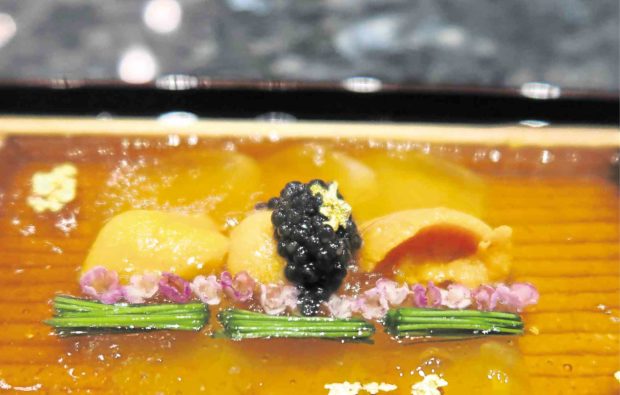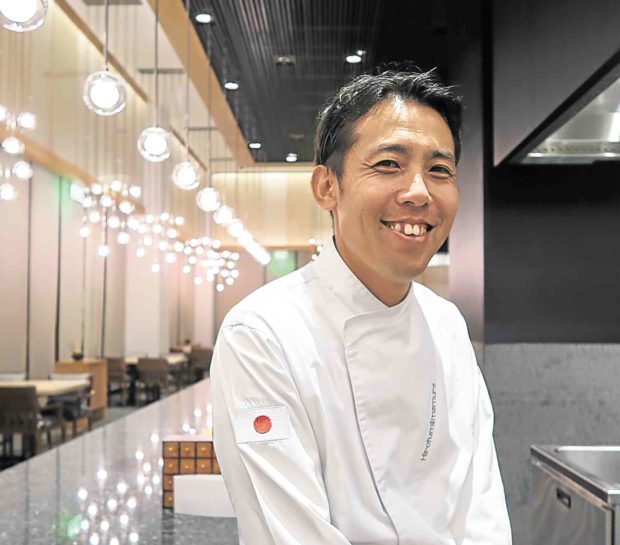Tasting dirty plates made this chef
Thanks to my good friend, wine connoisseur Alex Ong, I finally had an authentic, truly first class omakase experience in Manila.
If you love Tsukiji, Tsumura and Inagiku, you’ll be happy to find out that Kappou Imamura is even better—way better. It’s pricier, but every bite will be worth it.
I’d never even been to Okada Manila before this dinner. There’s something about casino hotels that turns me off, not to mention the drive to that area. But when Alex Ong tells you something is worth the drive, it really is.
True to my jaded expectations, when you enter the hotel, it reeks of tacky pomp. From magenta to salmon to purple, the lobby is a hot pink mess. The giant pink posts that look like mushrooms make you feel like you’re walking on the land of the Smurfs while the design on the bulbs switches the story to Aladdin. Then you see the floral carpet and clearly the inspiration zoomed past psychedelic into plain confusion.
Thankfully, that confusion is confined to the casino floor. Once you enter Kappou Imamura, there is a complete turnaround from tacky to elegant.
From the lamps that were imported from Japan to the bar stools imported from Cebu, you immediately sense elegant Japanese austerity where luxury is felt, not announced. Very classy.
Chef Hirofumi Imamura, whom the kappou is named after, works quietly behind the bar, personally preparing your meal.
A kappou is a traditional Japanese establishment where the owner/cook is visible from the counter or tables and can interact with the customers. Imamura explains that the purpose of this is to allow the chef to customize the meals for the guests. You can then eat omakase-style, i.e. where every dish is left to the dictates of the chef.
At Kappou Imamura, while there is also an a la carte menu, omakase is best. After all, Imamura is a Michelin-starred chef, receiving his star in 2015 while he was with Kazuo Okada in Hong Kong.
After Hong Kong, he moved to the Philippines to help open Okada Manila. He had a hand not only in the menu but in the creation of the entire restaurant, from the interior design to the state-of-the-art kitchen equipment.
Since he was cooking right in front of us, I had a great time getting to know the chef. He lived in New York for a long time so his English is very good.
He was executive chef of Sakagura in New York, an establishment known for its sake collection of 300 types, 200 of which you could order by the glass. It was full every night and even rated No. 1 in Zagat while Imamura was the chef sometime in 2004. The chef, incidentally, is also a sake sommelier so he created sake-pairing menus for this restaurant.
He shared that while he was at Sakagura, his mentor from Fukuoka, Japan visited, and told him that his food sucked. Humbled, he went back to Japan for a year to get his bearings again.
“Maybe my cooking had already become too New York, not anymore Japanese,” he said.
He volunteered to work without pay at Waketokuyama in Tokyo, a restaurant he admired, even starting out as a dishwasher. “Dishwashing is good because every single sauce is there (on the dirty plates), so before I would wash the plates I tasted the sauce because I needed to learn,” he shared. “So gross, chef!” I laughed, though impressed at his humble dedication to becoming a better cook.
He was then in his early 20s and determined to learn. After three months, he was told by the revered chef Hiromitsu Nozaki, “That is not good for your health.” So, to his delight, he was allowed to work for two weeks at each station of the restaurant.
After regaining his confidence as a Japanese chef, he went back to New York and got his position back as executive chef at Sakagura. During his break, he staged for two weeks at the Essex House of Alain Ducasse. Again, he worked without pay but shared how delighted he was that every day, each staff member had a full course meal similar to what was given to guests. “That’s a $300- meal every day! And we could taste all the sauces! Wow!” he beamed as he remembered the experience. He was able to work with Ducasse himself and he did not tell the others there that he was, in fact, already an executive chef.
Later he moved to Las Vegas and there met Mr. Okada. And he has been with Okada ever since.
His commitment to excellence is seen in every dish and it is truly a privilege to experience dinner by this chef.
Our welcome dish was served in a bowl, covered with paper, so that when you open it you first experience the aroma of sakura wood, the tree of cherry blossoms. You smell and pause for a while, taking it all in before having a taste of the slices of alfonsino fish or deep sea, big-eyed red snapper in miso vinegar beneath the smoke.
Then it’s mind-blowing dish after mind-blowing dish: A dainty serving of clam with okra, an intricately designed plate of baraccuda with ichiban dashi, an elegant serving of fluke with sea urchin, micro scallions and caviar, and a plate of kinki fish (that is really what it is called) caught by line from Hokkaido and brought to Okada Manila fresh, served on museum-piece plates that date back to 1600 A.D.!
“These plates were made 400 years ago,” chef Imamura shared. “These are copies, right?” I asked, as I could not believe that we would be allowed to eat off something that was 400 years old. “No, this is the real thing,” he said, bringing out the wooden box where the plates were kept and showing us the label on the box. It read, aside from a few Japanese characters, “1690-1720”. The Edo period. My jaw dropped.
“Mr. Okada has one of the biggest private collections of arts and antiques in Japan,” the chef explained. “He does not have space anymore in his museum in Hakone for some of his collections so he allows some of his restaurants to use pieces like this for special VIP guests.” What a privilege!
But it’s not just the plate but what is on the plate that is given attention. Tuna is treated almost as if it was sacred. First, the tuna is flown in fresh, not frozen, from Imamura’s supplier in Wakayama, Japan. The chef proudly shares he has a machine, possibly the only one in the Philippines, that allows them to dry age the tuna. What we had were slices from a tuna head dry-aged for 13 days.
Meat is also treated with much respect. For our sukiyaki, he served a sukiyaki of Ohmi beef from the Shiga prefecture. Reputedly even better than Kobe beef, Imamura explained that these black Japanese cattles are given massages, allowed to drink beer and made to listen to classical music. And the beef is only from the females because their bones are smaller and the meat is more tender. We were served A5 beef although the chef admitted he preferred A4, as the A5 has too much fat, although it sounded more opulent and has more marbling.
Like the tuna, the beef is a direct order and goes straight to Okada from chef Imamura’s supplier in Japan.
Even the tomatoes that accompanied the beef were sourced from the best, i.e., from Shizuoka, the same prefecture from where they sourced musk melons that were later served. “This is the best in the world,” Imamura explained.
I remembered the time I went to Tokyo and asked a VIP friend what he wanted as pasalubong. “Melons,” he replied. When I went to the shop, I saw that the melons were P6,000 each. I got him matcha Kitkats instead.
“It’s very tasty,” Imamura argued, and apparently the farmers move the melons so that it gets just the right amount of sunshine; plus there is temperature control and humidity control to achieve perfection.
The meal ends with this perfect melon, alongside homemade ice cream that the chef beautifully serves atop a little block of ice. I’d never seen ice cream served that way before. “So that it doesn’t melt,” he explained. Naturally.
This dinner costs around P10,000. But it is worth every bite. You can also ask for a customized dinner of around P5,000. Or you can go the whole nine yards and ask for a dinner of P50,000 a head. But make sure your money is hard-earned and not from taxpayers. There’s a huge sign on the casino floor that reads: “Government officials are not allowed.”
Alex was right. It really is worth the drive and worth the price. I think that in chef Imamura’s hands, this is, right now, the best Japanese restaurant in Manila.
Kappou Imamura, Okada Manila, New Seaside Drive, Entertainment City, Parañaque. For reservations, call (02) 5555799. Open daily (except Mondays) for lunch from 11 a.m. to 3 p.m. and dinner from 5:30 p.m. to 11 p.m. Reservations recommended for omakase dinners. Major credit cards accepted. Wheelchair accessible. Casual attire allowed. Tip for ladies: wear comfortable shoes; it’s quite a walk from the hotel entrance.


